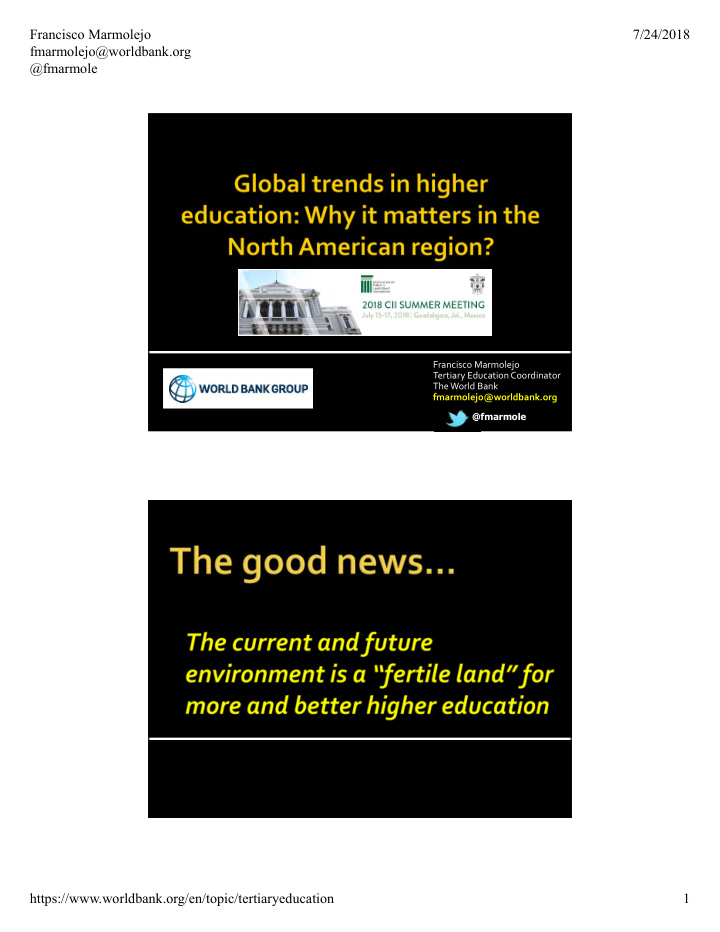



Francisco Marmolejo 7/24/2018 fmarmolejo@worldbank.org @fmarmole Francisco Marmolejo Tertiary Education Coordinator The World Bank fmarmolejo@worldbank.org @fmarmole https://www.worldbank.org/en/topic/tertiaryeducation 1
Francisco Marmolejo 7/24/2018 fmarmolejo@worldbank.org @fmarmole https://www.worldbank.org/en/topic/tertiaryeducation 2
Francisco Marmolejo 7/24/2018 fmarmolejo@worldbank.org @fmarmole https://www.worldbank.org/en/topic/tertiaryeducation 3
Francisco Marmolejo 7/24/2018 fmarmolejo@worldbank.org @fmarmole @fmarmole Email: fmarmolejo@worldbank.org https://www.worldbank.org/en/topic/tertiaryeducation 4
Francisco Marmolejo 7/24/2018 fmarmolejo@worldbank.org @fmarmole https://www.worldbank.org/en/topic/tertiaryeducation 5
Francisco Marmolejo 7/24/2018 fmarmolejo@worldbank.org @fmarmole https://www.worldbank.org/en/topic/tertiaryeducation 6
Francisco Marmolejo 7/24/2018 fmarmolejo@worldbank.org @fmarmole https://www.worldbank.org/en/topic/tertiaryeducation 7
Francisco Marmolejo 7/24/2018 fmarmolejo@worldbank.org @fmarmole https://www.worldbank.org/en/topic/tertiaryeducation 8
Francisco Marmolejo 7/24/2018 fmarmolejo@worldbank.org @fmarmole @fmarmole Email: fmarmolejo@worldbank.org Source: International Monetary Fund . https://www.worldbank.org/en/topic/tertiaryeducation 9
Francisco Marmolejo 7/24/2018 fmarmolejo@worldbank.org @fmarmole 70000 59531 60000 50000 45032 40000 30000 20000 8902 10000 0 GDP per capita USA Canada Mexico Latin America and the Caribbean Sub ‐ Saharan Africa East and Pacific Asia North Africa and Middle East South Asia High Income Countries 0 0.1 0.2 0.3 0.4 0.5 0.6 Source: Luis F. Lopez-Calva y N. Lusing 0: Equity of Total Income 1: Inequity of Total Income https://www.worldbank.org/en/topic/tertiaryeducation 10
Francisco Marmolejo 7/24/2018 fmarmolejo@worldbank.org @fmarmole Nearly 20 percent of America’s children–and 13 percent of all Americans–live in poverty. The Brookings Institution. https://www.worldbank.org/en/topic/tertiaryeducation 11
Francisco Marmolejo 7/24/2018 fmarmolejo@worldbank.org @fmarmole A net gain, but… https://www.worldbank.org/en/topic/tertiaryeducation 12
Francisco Marmolejo 7/24/2018 fmarmolejo@worldbank.org @fmarmole Economic Geographical integration will proximity will lead to result in geo ‐ harmonization of economic ‐ politic al institutional integration frameworks The increased integrated regional Tertiary education economy will will become require the support increasingly of a “North harmonized American” pool of talent Can you tell me Hmmm… about my I would, but I can’t future? read Spanish! https://www.worldbank.org/en/topic/tertiaryeducation 13
Francisco Marmolejo 7/24/2018 fmarmolejo@worldbank.org @fmarmole …and its internationalization @fmarmole Email: fmarmolejo@worldbank.org https://www.worldbank.org/en/topic/tertiaryeducation 14
Francisco Marmolejo 7/24/2018 fmarmolejo@worldbank.org @fmarmole .2 .15 Density .1 .05 0 0 5 10 15 20 Rate of return Based on comparable estimates of 545 observations, 131 economies, 1970‐2011 Source: Montenegro, C.E. & H.A. Patrinos (2013). Returns to Schooling around the World. In Latest year available: average rate of return is 9.9% The World Bank Region Primary Secondary Tertiary GDP/pc N (PPP 2005) World 10.3 6.9 16.8 6,719 74 Middle East and North Africa 9.4 3.5 8.9 3,645 7 South Asia 9.6 6.3 18.4 2,626 4 Eastern and Central Europe 8.3 4.0 10.1 6,630 7 High Income Economies 4.8 5.3 11.0 31,748 6 East Asia and Pacific 11.0 6.3 15.4 5,980 6 Latin America and Caribbean 9.3 6.6 17.6 7,269 20 Sub-Saharan Africa 13.4 10.8 21.9 2,531 24 * Latest available year between 2000-2011 Source: Montenegro, C.E. & H.A. Patrinos (2013). Returns to Schooling around the World. The World Bank https://www.worldbank.org/en/topic/tertiaryeducation 15
Francisco Marmolejo 7/24/2018 fmarmolejo@worldbank.org @fmarmole Source: Montenegro, C.E. & H.A. Patrinos (2013). Returns to Schooling around the World. The World Bank https://www.worldbank.org/en/topic/tertiaryeducation 16
Francisco Marmolejo 7/24/2018 fmarmolejo@worldbank.org @fmarmole @fmarmole Email: fmarmolejo@worldbank.org @fmarmole Email: fmarmolejo@worldbank.org https://www.worldbank.org/en/topic/tertiaryeducation 17
Francisco Marmolejo 7/24/2018 fmarmolejo@worldbank.org @fmarmole Tertiary Education Primary Education https://www.worldbank.org/en/topic/tertiaryeducation 18
Francisco Marmolejo 7/24/2018 fmarmolejo@worldbank.org @fmarmole https://www.worldbank.org/en/topic/tertiaryeducation 19
Francisco Marmolejo 7/24/2018 fmarmolejo@worldbank.org @fmarmole @fmarmole Email: fmarmolejo@worldbank.org https://www.worldbank.org/en/topic/tertiaryeducation 20
Francisco Marmolejo 7/24/2018 fmarmolejo@worldbank.org @fmarmole Made in The Netherlands With ingredients from Morocco. Distributed by a Chinese company For sale in Delhi. @fmarmole Email: fmarmolejo@worldbank.org https://www.worldbank.org/en/topic/tertiaryeducation 21
Francisco Marmolejo 7/24/2018 fmarmolejo@worldbank.org @fmarmole Bridging gap between education and employment 76.9% Funding models for TE 69.2% Improving quality assurance 69.2% Improving governance 69.2% Role of the private sector in TE 61.5% Equity and access to TE 53.8% Developing capacity of TEIs in science and innovation 53.8% Innovation in educational delivery models used by TEIs 46.2% Articulation btw different types of TEIs and with… 38.5% Non ‐ university post ‐ secondary sector 38.5% Fostering internationalization 38.5% Greater focus on TEIs versus governments 38.5% Diversification in institutional mission of TEIs 15.4% 0.0% 20.0% 40.0% 60.0% 80.0% * Multiple responses @fmarmole Email: fmarmolejo@worldbank.org https://www.worldbank.org/en/topic/tertiaryeducation 22
Francisco Marmolejo 7/24/2018 fmarmolejo@worldbank.org @fmarmole @fmarmole Email: fmarmolejo@worldbank.org https://www.worldbank.org/en/topic/tertiaryeducation 23
Francisco Marmolejo 7/24/2018 fmarmolejo@worldbank.org @fmarmole More than ever more people are having access to education … More than ever more people are having access to higher education … 250 200 150 100 Global enrollment in tertiary education 50 (Millions of students) 0 https://www.worldbank.org/en/topic/tertiaryeducation 24
Francisco Marmolejo 7/24/2018 fmarmolejo@worldbank.org @fmarmole 80 World 70 High income countries Upper middle income countries 60 Lower middle income countries Low income countries 50 40 30 20 10 0 1970 1975 1980 1985 1990 1995 2000 2005 2010 2015 Source: UIS database Projections of the number of 25 ‐ 34 year ‐ olds with tertiary education, 2005 ‐ 2030 Note: Figures are estimates based on available data. Population estimates are based on OECD’s annual population projections Source: OECD, UNESCO, and National Statistics websites for Argentina, China, India, Indonesia, Saudi Arabia and South Africa https://www.worldbank.org/en/topic/tertiaryeducation 25
Francisco Marmolejo 7/24/2018 fmarmolejo@worldbank.org @fmarmole 14% 8 % https://www.worldbank.org/en/topic/tertiaryeducation 26
Francisco Marmolejo 7/24/2018 fmarmolejo@worldbank.org @fmarmole Richest Total Poorest https://www.worldbank.org/en/topic/tertiaryeducation 27
Francisco Marmolejo 7/24/2018 fmarmolejo@worldbank.org @fmarmole WORLD POPULATION LIVING IN CITIES 75 % 50 % 10 % 1910 2007 2050 https://www.worldbank.org/en/topic/tertiaryeducation 28
Francisco Marmolejo 7/24/2018 fmarmolejo@worldbank.org @fmarmole Decreasing >5 % Increasing > 40 % Source: World Bank. World Development Report. 2015 https://www.worldbank.org/en/topic/tertiaryeducation 29
Francisco Marmolejo 7/24/2018 fmarmolejo@worldbank.org @fmarmole Ostana, Italy in the Washington Post February 1, 2016 https://www.washingtonpost.com/news/worldviews/wp/2016/02/01/for-the-first-time-in-28-years-a-baby-has-been- born-in-this-italian-town/ 350 300 250 200 150 100 50 0 Millions of inhabitants USA Canada Mexico https://www.worldbank.org/en/topic/tertiaryeducation 30
Francisco Marmolejo 7/24/2018 fmarmolejo@worldbank.org @fmarmole 60 50 40 30 20 10 0 USA Canada Mexico https://www.worldbank.org/en/topic/tertiaryeducation 31
Francisco Marmolejo 7/24/2018 fmarmolejo@worldbank.org @fmarmole Large or small country?: The case of Nunavut Total Area: 2,038,722 km 2 ( 787,155 sq mi) Total Population: 31,906 inhabitants Net Migration (in millions of people). 1960‐2010 Source: World Bank (2012). World Databank: Net Migration https://www.worldbank.org/en/topic/tertiaryeducation 32
Francisco Marmolejo 7/24/2018 fmarmolejo@worldbank.org @fmarmole The demographic structure from a regional point of view Age 90-94 80-84 70-74 60-64 50-54 40-44 Canada 30-34 Mexico 20-24 USA 10-14 0-4 0 5 10 15 20 25 30 35 Millions of inhabitants Sourcee: Jaime Parada, CONACYT Source: Statista. 2018 https://www.worldbank.org/en/topic/tertiaryeducation 33
Francisco Marmolejo 7/24/2018 fmarmolejo@worldbank.org @fmarmole @fmarmole Email: fmarmolejo@worldbank.org https://www.worldbank.org/en/topic/tertiaryeducation 34
Recommend
More recommend